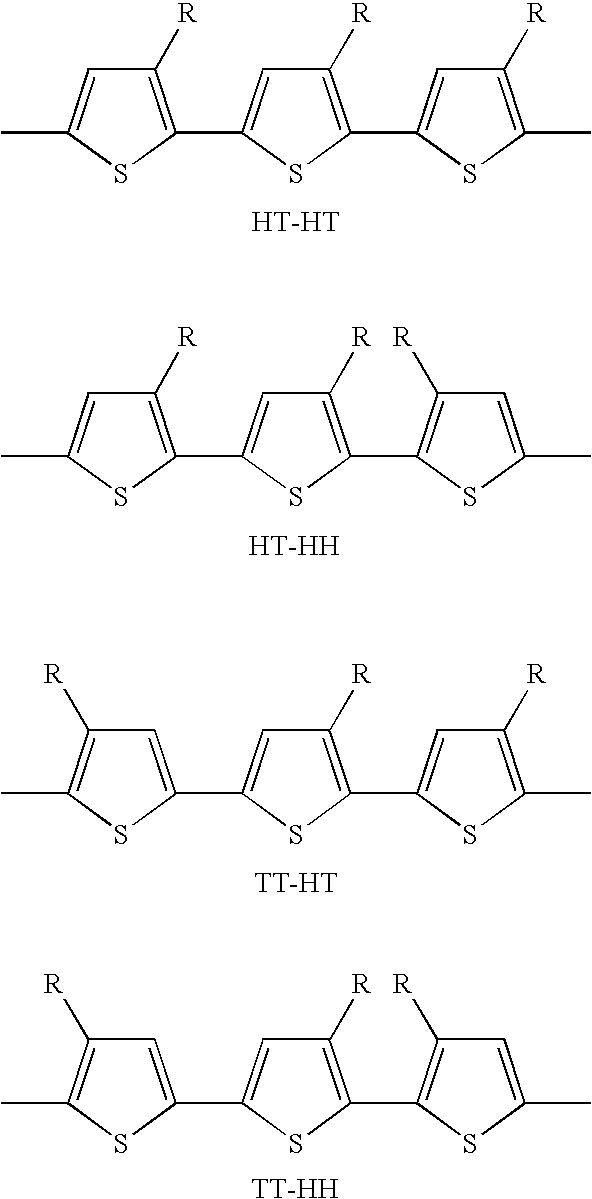Process of preparing regioregular polymers
a technology of regioregular polymers and polymers, which is applied in the direction of sustainable manufacturing/processing, non-metal conductor manufacturing, and final product manufacturing, etc., can solve the problems of reduced device performance, increased glass transition temperature, and device failure during operation
- Summary
- Abstract
- Description
- Claims
- Application Information
AI Technical Summary
Benefits of technology
Problems solved by technology
Method used
Image
Examples
example 1
[0164]21.32 g of 2,5-dibromo-3-hexylthiophene are dissolved in 125.4 g of THF under nitrogen, followed by addition of 32.58 g of a solution of n-butylmagnesiumchloride in THF (˜2 M) to generate a Grignard mixture, which is heated to 56° C.
[0165]In parallel 220 mg of 5,5′-dibromo-2,2′-bithiophene are dissolved in 10 ml of THF in a separate vessel under nitrogen. 271 mg of dppp and 180 mg of Ni(COD)2 are added, respectively, and 7 ml of THF are used to rinse each time. After stirring the catalyst mixture at 60° C. for 1 hour it is added to the above-mentioned Grignard mixture.
[0166]The polymerisation mixture is heated to reflux for 2.5 hours, then 80 ml of HCl (1 M) and 200 ml of methanol are added, respectively, at 56° C. After cooling the mixture to 23° C. the solid crude product is filtered off and rinsed with methanol. The solid is dissolved in 120 ml of chlorobenzene at 55° C., and addition of a mixture of 180 ml of methanol and 20 ml of HCl (1 M) results in precipitation of the ...
example 2
[0169]2.30 kg of 2,5-dibromo-3-hexylthiophene are dissolved in 28 kg of THF under nitrogen, followed by addition of 3.3 kg of a solution of n-butylmagnesium chloride in THF (˜2 M) to generate a Grignard mixture, which is heated to 40° C.
[0170]In parallel 46 g of 5,5′-dibromo-2,2′-bithiophene are dissolved in 2050 g of THF in a separate vessel under nitrogen. 29 g of dppp and 19 g of Ni(COD)2 are added, respectively. After stirring the catalyst mixture at 60° C. for 10 min it is added to the above-mentioned Grignard mixture.
[0171]The polymerisation mixture is heated to reflux for 2 hours, then 2 kg of HCl (25%) and 2 kg water are added, followed by 28 kg of methanol at 56° C. After cooling the mixture to 23° C. the solid crude product is filtered off and rinsed with methanol. The solid is dissolved in 22 kg of chlorobenzene at 55° C., and addition of a mixture of 25 kg of methanol 1 kg of HCl (25%) and 1 kg of water results in precipitation of the product. After cooling to 23° C. the...
example 3
[0174]3.50 kg of 2,5-dibromo-3-hexylthiophene are dissolved in 18 kg of THF under nitrogen, followed by addition of 5.1 kg of a solution of n-butylmagnesium chloride in THF (˜2 M) to generate a Grignard mixture, which is heated to 25° C.
[0175]In parallel 87 g of 2,5-dibromo-3-hexylthiophene are dissolved in 7.5 kg of THF in a separate vessel under nitrogen. 112 g of dppp and 73 g of Ni(COD)2 are added, respectively. After stirring the catalyst mixture at 60° C. for 10 min it is cooled to 25° C. and added to the above-mentioned Grignard mixture.
[0176]The polymerisation mixture is heated to reflux for 5 min, then 0.7 kg of a solution of n-butylmagnesium chloride in THF (˜2 M) are added and refluxed for another 10 min. Then 8.5 kg of HCl (25%) and 40 kg of methanol are added at 56° C.-20° C. Then the solid crude product is filtered off and rinsed with methanol and acetone. The solid is dissolved in 35 kg of chlorobenzene at 55° C., and dropping this solution into a mixture of 70 kg of ...
PUM
| Property | Measurement | Unit |
|---|---|---|
| Fraction | aaaaa | aaaaa |
| Transport properties | aaaaa | aaaaa |
Abstract
Description
Claims
Application Information
 Login to View More
Login to View More - R&D
- Intellectual Property
- Life Sciences
- Materials
- Tech Scout
- Unparalleled Data Quality
- Higher Quality Content
- 60% Fewer Hallucinations
Browse by: Latest US Patents, China's latest patents, Technical Efficacy Thesaurus, Application Domain, Technology Topic, Popular Technical Reports.
© 2025 PatSnap. All rights reserved.Legal|Privacy policy|Modern Slavery Act Transparency Statement|Sitemap|About US| Contact US: help@patsnap.com



